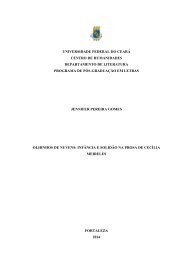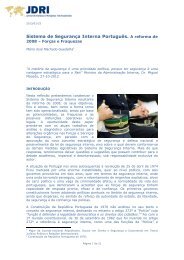1POTXAdSn
1POTXAdSn
1POTXAdSn
You also want an ePaper? Increase the reach of your titles
YUMPU automatically turns print PDFs into web optimized ePapers that Google loves.
notas explicativas<br />
Os briófitos são pequenas plantas, não vasculares, que<br />
incluem três grupos taxonómicos bem diferenciados:<br />
musgos, hepáticas e antocerotas, todos com a geração<br />
gametófita dominante. Aceita-se que estes grupos estarão<br />
na origem das plantas terrestres, embora as relações<br />
evolutivas não estejam ainda totalmente esclarecidas.<br />
Fisiologicamente, os briófitos são plantas poiquilohídricas,<br />
uma vez que têm a capacidade de suspender a<br />
actividade metabólica quando não existe água disponível<br />
no meio. Ecologicamente, desempenham funções<br />
importantes, sobretudo na retenção de água, reciclagem<br />
de nutrientes, minimização da erosão e criação de<br />
micro-habitats para outros organismos. Embora a sua<br />
presença possa passar despercebida aos menos observadores,<br />
a sua riqueza nos Açores é assinalável, comparável<br />
à que se encontra nos arquipélagos da Madeira<br />
e das Canárias, sendo o número de espécies superior<br />
ao das plantas vasculares nativas. Nesta lista são consideradas<br />
480 espécies e sub-espécies de briófitos: cinco<br />
antocerotas, 164 hepáticas e 311 musgos.<br />
Este trabalho actualiza, quer a nível taxonómico,<br />
quer a nível de distribuição geográfica, a última lista<br />
de briófitos dos Açores, publicada em 2005 (Gabriel<br />
et al. 2005, ver também Sjögren 2001) e, embora inclua<br />
algumas novidades de herbário, a maior parte das<br />
alterações está publicada na literatura da especialidade<br />
(ex. Claro et al. 2009). Estão em preparação outros<br />
trabalhos onde serão discriminadas as referências bibliográficas<br />
por ilha, bem como as novas localidades e<br />
notas taxonómicas.<br />
Seguiu-se a classificação taxonómica proposta em<br />
Goffinet & Shaw (2009): Renzaglia et al. (2009) para<br />
as antocerotas, Crandal-Stotler et al. (2009) para as<br />
hepáticas e Goffinet et al. (2009) para os musgos. Os<br />
grupos taxonómicos superiores são listados dos mais<br />
primitivos para os mais evoluídos, enquanto as famílias,<br />
géneros, espécies e subespécies são listados<br />
por ordem alfabética. As obras de Hill et al. (2006)<br />
e de Schumacker & Vána (2005) foram respectivamente<br />
usadas como referência para a nomenclatura de<br />
musgos e de antocerotas e hepáticas, embora com algumas<br />
actualizações (ex. Ros et al. 2007; Burghardt<br />
& Gradstein 2008; González-Mancebo et al. 2008;<br />
Stech et al. 2008; Werner et al. 2009). As espécies<br />
100<br />
explanatory notes<br />
Bryophytes are small, nonvascular plants, which<br />
include three very different taxonomic groups:<br />
mosses, liverworts and hornworts, all with a dominant<br />
gametophyte generation. It is accepted that these<br />
groups are at the origin of all land plants, although the<br />
evolutionary relationships are not fully understood.<br />
Physiologically, the bryophytes are poikilohydric,<br />
since they have the ability to suspend the metabolic<br />
activity when water is not readily available in the<br />
environment. Ecologically, they play important roles,<br />
especially in water retention, nutrient cycling, erosion<br />
prevention and creation of micro-habitats for other<br />
organisms. Although bryophytes are often unnoticed<br />
by untrained observers, their richness in the Azores<br />
is remarkable, and comparable to that found in the<br />
archipelagos of Madeira and the Canary Islands. In<br />
fact, the total number of Azorean bryophyte species<br />
is higher than that of native vascular plants. In this list<br />
we consider 480 species and subspecies of bryophytes:<br />
five hornworts, 164 liverworts and 311 mosses.<br />
This work updates, the final list of bryophytes of<br />
the Azores, published in 2005 (Gabriel et al. 2005,<br />
see also Sjögren 2001), both in terms of geographical<br />
distribution of the species and their taxonomy, and<br />
although it includes some new herbarium records,<br />
most of the additions and amendments are published<br />
in specialized literature (e.g. Claro et al. 2009). Other<br />
works are being prepared, with the indication of the<br />
literature for each island, as well as new locations and<br />
taxonomic notes.<br />
We followed the taxonomy proposed in Shaw<br />
& Goffinet (2009): Renzaglia et al. (2009) for the<br />
hornworts, Crandal-Stotler et al. (2009) for liverworts<br />
and Goffinet et al. (2009) for mosses. Higher taxa<br />
are listed in a sequence inferred to be from the less<br />
to the most derived groups, with closely related taxa<br />
placed near to one another. The families and genera<br />
are listed in alphabetical sequence. The works of Hill<br />
et al. (2006) and Schumacker & Vána (2005) were<br />
respectively used as reference for the nomenclature<br />
of mosses and liverworts and hornworts, with some<br />
updates (e.g. Ros et al. 2007; Burghardt & Gradstein<br />
2008; González-Mancebo et al. 2008; Stech et al.<br />
2008; Werner et al. 2009). Species considered doubtful
















